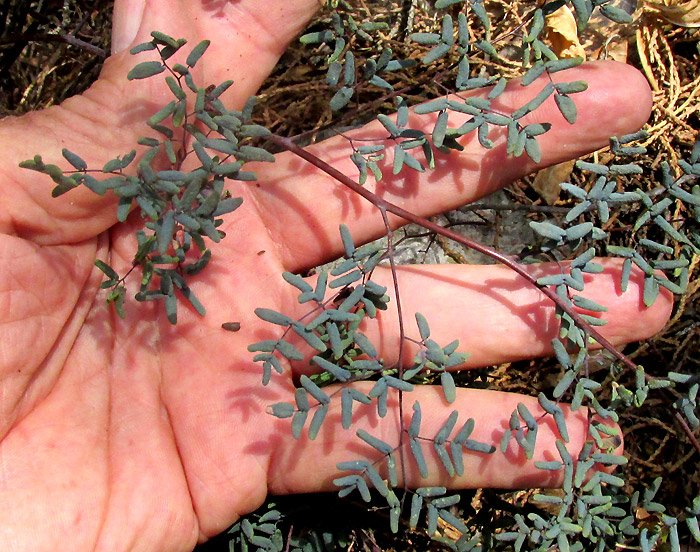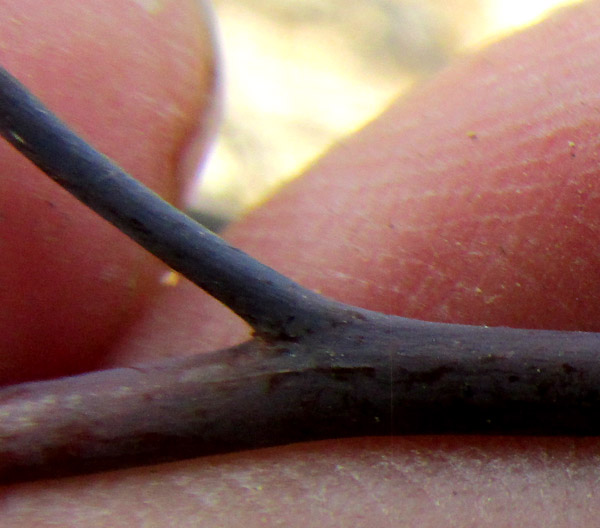Excerpts from Jim Conrad's
Naturalist Newsletter
entry from field notes dated May 4, 2023, taken about 150m uphill on NE-facing slope, above intersection of road from Hwy 120 to San Joaquín, with road to El Doctor; juniper and pine forest on limestone bedrock; elevation ±2425m (7950 ft); Eastern Sierra Madre mountains of east-central Querétaro state, MÉXICO, (N20.88°, W99.62°)
FALSE CLOAK FERN

The above fern grew beneath juniper trees on a rocky slope so steep that I could only touch it with my legs hanging over the ledge. At that distance, with its slender, blackish, stiff-brittle-looking stems and small leaflets, or pinnules, it looked like one of the cliffbrakes, genus Pellaea, such as the Purple-stem Cliffbrake, often seen in such rocky habitats in North America. However, this fern's pinnules were so small and bluish-silvery that it was curious. For closer examination I could only fetch a tip of a frond by pinching one off using my size 13 shoes (size 47 Europe) like tweezers. That affording the closer look shown below:

The pinnules were only about 3.5mm long (9/64 inch). The whole blade shown above is the leaf, and it branches into subsections, which again are divided into divisions, which themselves divide into subdivisions, and those subdivisions are represented by one to 7 pinnules.

Viewed from below, it's seen that the pinnule margins turn under to form "false indusia," within which brown, grainy sporangia take shelter, each sporangium containing 32 spores. During the later identification process I'd note that important field marks to take into consideration are that the individual pinnules are rounded at their tips, not sharply pointed, and that on each side of each pinnule's stem, or stipe, the pinnule bases are broadly rounded and project below the point of attachment with the stipe. Here's a closer look at sporangia peeping from beneath the false indusia:

On the purple stems there were no hairs or scales, though scattered white specks suggested hints of them. The same was true of lower stem divisions:

I was fairly certain this was some kind of cliffbreak, genus Pallaea, but searching in that genus only turned up the poorly understood and controversial Pellaea wrightiana, often lumped into the rat's-nest species Pellaea ternifolia, both of which were tantalizingly similar to our fern, but not quite. Those ferns produce pinnules a little larger, their pinnules are sharply tipped instead of rounded like ours, tend to be hairy, and the pinnules' bluish-silvery "glaucescence" isn't as pronounced as on our ferns.
Finally I read that the genus Pellaea is often confused with the genus Argyrochosma, species of which traditionally were assigned to Pellaea. Argyrochosma is represented by five known species in our upland region of central Mexico known as the Bajío. Since our fern's blades aren't covered with mealy scales, or farina, and its pinnule bases have those lobes projecting backward, our fern easily revealed itself as ARGYROCHOSMA FORMOSA.
Argyrochosma formosa occurs from northeastern Mexico south in the uplands into Guatemala, and is known by no English name, though all members of the genus Argyrochosma can be called false cloak ferns. "Real" cloak ferns are members of the catch-all genus Notholaena, of which our fern used to be a member. Convergent evolution has produced a cluster of somewhat unrelated but very similar species all adapted to rocky, dry, sunlight drenched environments. Argyrochosma is definitely a stand-alone genus, though, if only because its chromosome number is x=27, while for the cliffbrakes, Pellaea, it's x=29, and for "real"cloak ferns, Notholaena, it's x=30.
Despite ferns growing on rocks often being considered good for breaking up kidney stones, at least in traditional medicine, I find no uses at all mentioned for our fern. It's just one of those species content for its roots to hold soil in place on steep slopes, and eventually to return its nutrients and organic matter to the soil, which is all very generous of it.